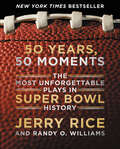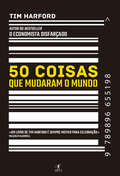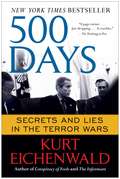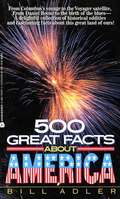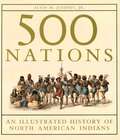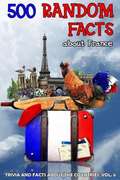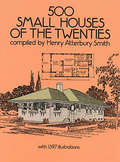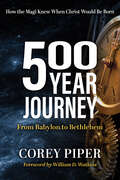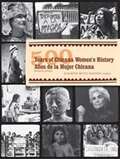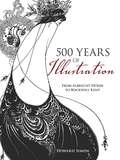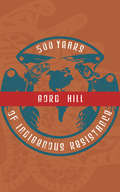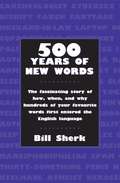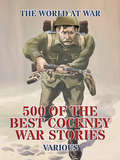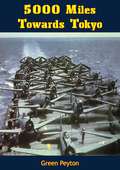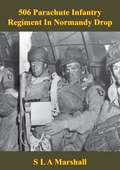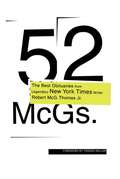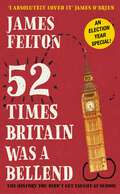- Table View
- List View
50 Years, 50 Moments: The Most Unforgettable Plays in Super Bowl History
by Jerry Rice Randy O. WilliamsIn commemoration of the fiftieth anniversary of America’s most beloved sporting event—the Super Bowl—an authoritative collection of the most pivotal plays through the decades, compiled by the legendary Jerry Rice, and illustrated with dozens of color photographs.New York Times bestseller 50 Years, 50 Moments celebrates five decades’ worth of memories, insights, and personal experiences of Super Sunday. Super Bowl MVP Jerry Rice has compiled his list of the most iconic, strategic, and record-breaking moments in football history from the Super Bowl’s inception to today—from the Green Bay Packers and Kansas City Chiefs in Super Bowl I; to the amazing Miami Dolphins championship in Super Bowl VII that capped their seventeen-game undefeated season; to the heart-stopping Super Bowl XXV in which the New York Giants beat the Buffalo Bills 20-19; and Super Bowl XLIX’s amazing last-second victory by the New England Patriots over defending champion Seattle Seahawks 28-24.A Hall of Fame wide receiver who has played alongside and against some of the greatest players in the NFL, Jerry Rice, joined by accomplished sports researcher and journalist Randy O. Williams, draws on his intimate knowledge and insight of the game to highlight remarkable moments from this greatest game in modern sports. Rice’s access to the NFL means that 50 Years, 50 Moments is chock full of memories and insights directly from the athletes and coaches who were involved in these moments.Pulling together all the catches, the interceptions, the fumbles and triumphant touchdowns that have made the Super Bowl an unforgettable experience. 50 Years, 50 Moments features marquee names like Joe Montana, Vince Lombardi, Roger Staubach, Walter “Sweetness” Payton, Terry Bradshaw, Joe Namath, Lawrence Taylor, “Mean Joe” Greene, as well as Tom Brady and is a handsome must-have keepsake for football fans everywhere that is sure to be treasured for generations to come.
50 Years: Relive the Magic, Artist by Artist
by Julien BitounForeword by Woodstock co-founder, Michael Lang.3 days. 33 concerts. 2 deaths. 2 births. 500,000 people. And another 250,000 stuck in traffic trying to get in. Woodstock was a festival like no other. Now, on its 50th anniversary, relive every moment.Detailed text and evocative photographs tell the full story of every single act that performed - when they took to the stage, what songs they played, who was there, what they were like. From The Who to Hendrix, Jefferson Airplane to Creedence Clearwater Revival, every single second is an experience to enjoy over and over again.Also includes fascinating features on the stories around Woodstock, from the unique social and political context to the drugs, the free love, the film, the albums and the legacy.
50 Years: Relive the Magic, Artist by Artist
by Julien BitounForeword by Woodstock co-founder, Michael Lang.3 days. 33 concerts. 2 deaths. 2 births. 500,000 people. And another 250,000 stuck in traffic trying to get in. Woodstock was a festival like no other. Now, on its 50th anniversary, relive every moment.Detailed text and evocative photographs tell the full story of every single act that performed - when they took to the stage, what songs they played, who was there, what they were like. From The Who to Hendrix, Jefferson Airplane to Creedence Clearwater Revival, every single second is an experience to enjoy over and over again.Also includes fascinating features on the stories around Woodstock, from the unique social and political context to the drugs, the free love, the film, the albums and the legacy.
50 coisas que mudaram o mundo
by Tim HarfordDo autor do bestseller O Economista DisfarçadoUM DOS MELHORES LIVROS DE ECONOMIA DO ANO SUNDAY TIMES * AMAZON * FINANCIAL TIMES * BLOOMBERG «Um livro de Tim Harford é sempre motivo para celebração.»Malcolm Gladwell Quem inventou o dinheiro em papel? De que forma a pílula aumentou o número de mulheres na universidade? Como é possível que o gramofone tenha aumentado a desigualdade social? E porque é que o código de barras levou ao fecho de pequenas lojas de bairro? Com o talento que o tornou o mais célebre divulgador económico, o autor do memorável e revolucionário O Economista Disfarçado faz um retrato surpreendente das grandes ideias e invenções que, inesperadamente, mudaram para sempre o curso da História. São ideias e invenções que nos contam uma história, não só do génio humano, mas também dos complexos sistemas invisíveis que nos rodeiam e manipulam, conhecidos como Economia.Dos robots ao arame farpado, passando pelo Iphone, pela charrua e pela famosa estante Billy do Ikea, vão-se tornando claras as ligações entre as invenções mais revolucionárias e as mudanças económicas e sociais mais drásticas e memoráveis. Num mundo onde o ritmo da inovação é frenético e não dá sinais de querer abrandar, o leitor começa, então, a perceber onde está, como aqui chegou e para onde poderá estar a dirigir-se. Em 50 coisas que mudaram o mundo, o incontornável Tim Harford volta a fazer o impossível e leva o leitor numa viagem tão fascinante quanto esclarecedora pelos momentos mais marcantes da história da economia - e do mundo. Se já sabíamos que tudo está ligado, Tim Harford explica-nos, finalmente, como. Os elogios da crítica: «Uma das conquistas de 50 coisas que mudaram o mundo é o modo como apresenta uma perspectiva do crescimento de forma a que o mais comum dos leitores consiga compreendê-lo. Harford consegue explicar-nos conceitos como produtividade, crescimento económico, monopólio, regulação e outros tópicos fundamentais sem recorrer a terminologia técnica ou a gráficos e tabelas intimidantes. Só isso pressupõe, também, uma espécie de inventividade.»Wall Street Journal «Este livro é uma surpresa constante. Está repleto de inovações que não conhecia, bem como de inovações que julgava que conhecia mas afinal não conhecia assim tão bem.»The Times «Tantos pormenores fascinantes# O estilo de Harford é envolventemente mordaz e o seu livro é uma soberba introdução a alguns dos produtos mais importantes do engenho humano.»Sunday Times «O sempre excelente Tim Harford volta a sua atenção para as invenções. O arado, o gramofone, a pílula, a estante Billy. Uma e outra vez,Harford demonstra como as invenções espoletam toda a sorte de reacções em cadeia.»Evening Standard «A atenção ao pormenor de Harford é reveladora do seu talento enquanto analista económico mas também enquanto comentador. Os capítulos sobre o arame-farpado, os passaportes, a pílula, o leite em pó para lactantes, o código de barras ou até o básico do Ikea, a estante Billy, estão muitíssimo bem documentados, têm energia e ritmo, e são genuinamente intrigantes.»Times Literary Supplement
50+ Years of AIMETA: A Journey Through Theoretical and Applied Mechanics in Italy
by Giuseppe RegaThe book retraces the history of the Italian Association of Theoretical and Applied Mechanics (AIMETA) since its establishment in 1965. AIMETA is the official Italian association of mechanics adhering to IUTAM (International Union of Theoretical and Applied Mechanics), which organizes and coordinates a meaningful number of research activities, the most important of which are the biennial National Congress and the internationally renowned journal “Meccanica”, published by Springer. Besides collecting and organizing all related important data and information, as far as possible, by distinguishing among the five scientific areas – general mechanics, solids, structures, fluids, machines – encompassed by AIMETA, the history of the association is assumed as a proper perspective to overview the evolution of theoretical and applied mechanics in Italy over about the last fifty years. This is accomplished in the first part of the book. with also a specific focus on the mechanics of solids and structures, where the biographies of a meaningful number of recognized Italian scholars of mechanics in all areas are also provided, along with testimonials and memories by a few senior people meaningfully involved with AIMETA and Italian mechanics. The second part gives an account, although unavoidably incomplete, of recent developments of mechanical sciences in Italy, as reflected also in the activities of AIMETA and with reference to the international context. Contributions by a number of invited senior scholars, still very active, consist of overviews on some scientific themes in the various areas, summaries of achievements of research groups, expressions of research viewpoints, prospects for future developments.
500 Days: Secrets and Lies in the Terror Wars
by Kurt EichenwaldKurt Eichenwald--New York Times bestselling author of Conspiracy of Fools and The Informant-- recounts the first 500 days after 9/11 in a comprehensive, compelling page-turner as gripping as any thriller. In 500 Days, master chronicler Kurt Eichenwald lays bare the harrowing decisions, deceptions, and delusions of the eighteen months that changed the world forever, as leaders raced to protect their citizens in the wake of 9/11. Eichenwald's gripping, immediate style and trueto- life dialogue puts readers at the heart of these historic events, from the Oval Office to Number 10 Downing Street, from Guantanamo Bay to the depths of CIA headquarters, from the al-Qaeda training camps to the torture chambers of Egypt and Syria. He reveals previously undisclosed information from the terror wars, including never before reported details about warrantless wiretapping, the anthrax attacks and investigations, and conflicts between Washington and London. With his signature fast-paced narrative style, Eichenwald-- whose book, The Informant, was called "one of the best nonfiction books of the decade" by The New York Times Book Review--exposes a world of secrets and lies that has remained hidden for far too long.
500 Days: Secrets and Lies in the Terror Wars
by Kurt EichenwaldKurt Eichenwald--New York Times bestselling author of Conspiracy of Fools and The Informant-- recounts the first 500 days after 9/11 in a comprehensive, compelling page-turner as gripping as any thriller. In 500 Days, master chronicler Kurt Eichenwald lays bare the harrowing decisions, deceptions, and delusions of the eighteen months that changed the world forever, as leaders raced to protect their citizens in the wake of 9/11. Eichenwald's gripping, immediate style and trueto- life dialogue puts readers at the heart of these historic events, from the Oval Office to Number 10 Downing Street, from Guantanamo Bay to the depths of CIA headquarters, from the al-Qaeda training camps to the torture chambers of Egypt and Syria. He reveals previously undisclosed information from the terror wars, including never before reported details about warrantless wiretapping, the anthrax attacks and investigations, and conflicts between Washington and London. With his signature fast-paced narrative style, Eichenwald-- whose book, The Informant, was called "one of the best nonfiction books of the decade" by The New York Times Book Review--exposes a world of secrets and lies that has remained hidden for far too long.
500 Days: Secrets and Lies in the Terror Wars
by Kurt EichenwaldKurt Eichenwald--New York Times bestselling author of Conspiracy of Fools and The Informant-- recounts the first 500 days after 9/11 in a comprehensive, compelling page-turner as gripping as any thriller. In 500 Days, master chronicler Kurt Eichenwald lays bare the harrowing decisions, deceptions, and delusions of the eighteen months that changed the world forever, as leaders raced to protect their citizens in the wake of 9/11. Eichenwald's gripping, immediate style and trueto- life dialogue puts readers at the heart of these historic events, from the Oval Office to Number 10 Downing Street, from Guantanamo Bay to the depths of CIA headquarters, from the al-Qaeda training camps to the torture chambers of Egypt and Syria. He reveals previously undisclosed information from the terror wars, including never before reported details about warrantless wiretapping, the anthrax attacks and investigations, and conflicts between Washington and London. With his signature fast-paced narrative style, Eichenwald-- whose book, The Informant, was called "one of the best nonfiction books of the decade" by The New York Times Book Review--exposes a world of secrets and lies that has remained hidden for far too long.
500 Days: Secrets and Lies in the Terror Wars
by Kurt EichenwaldKurt Eichenwald--New York Times bestselling author of Conspiracy of Fools and The Informant-- recounts the first 500 days after 9/11 in a comprehensive, compelling page-turner as gripping as any thriller. In 500 Days, master chronicler Kurt Eichenwald lays bare the harrowing decisions, deceptions, and delusions of the eighteen months that changed the world forever, as leaders raced to protect their citizens in the wake of 9/11. Eichenwald's gripping, immediate style and trueto- life dialogue puts readers at the heart of these historic events, from the Oval Office to Number 10 Downing Street, from Guantanamo Bay to the depths of CIA headquarters, from the al-Qaeda training camps to the torture chambers of Egypt and Syria. He reveals previously undisclosed information from the terror wars, including never before reported details about warrantless wiretapping, the anthrax attacks and investigations, and conflicts between Washington and London. With his signature fast-paced narrative style, Eichenwald-- whose book, The Informant, was called "one of the best nonfiction books of the decade" by The New York Times Book Review--exposes a world of secrets and lies that has remained hidden for far too long.
500 Great Facts to Know About America
by Bill AdlerA pro-American look at history calls for a celebration of American achievement, discussing how the pilgrims staved off starvation, facts behind the song ""Yankee Doodle Dandy,"" the mystery behind Zachary Taylor's death, and more.
500 Nations: An Illustrated History of North American Indians
by Alvin M. JosephyThe story of Native American leaders, customs, political systems, and ways of life, this is American history from the Native American perspective: friendship, betrayal, war, and ultimately, the loss of homeland. A companion volume to the CBS series produced by Kevin Costner, Jack Leustig, and James Wilson scheduled to air in 1995. Illustrations & photos.
500 Random Facts: About France (Trivia And Facts About The Countries #Volume 6)
by Lena ShawDid you know that the French President Charles de Gaulle has survived 32 assassination attempts? Have you heard that Hitler had to climb 1,665 stairs in order to get to the top of the Eiffel Tower because the French cut the elevator's cables? Do you like to read tons of new and unobvious facts about France; to feel the spirit of romantic streets of Paris and to smell over 10 billion baguettes, which are baked in France yearly? If your answer is YES, this book is for you. <p><p>500 Random Facts about France is the sixth book in the series Trivia and Facts about the Countries. The author has tried to make it even better than the previous five books, considering all the feedback received. This book is a gold-mine of random facts about France. All content is unique and family-friendly. Some of these facts are completely crazy or unexpected, while the others are simply fun and amusing. Facts describe both historical events and the modern society and culture of France; its celebrities, athletes, scientists, inventors, and some less-known French people.
500 Small Houses of the Twenties (Dover Architecture)
by Henry Atterbury SmithSpurred by a rapidly expanding economy and abundant resources of land, building materials and skilled labor, the dream of building and owning one's own home became a reality in America in the 1920s. With the beginning market for small- to medium-sized one-family dwellings came a succession of innovative home designs that transformed American domestic architecture.This outstanding book presents 500 small-home designs of the 1920s as they appeared in a major architectural publication of 1923. Many are by leading domestic architects of the period. Each design is presented in a handsome perspective drawing or photograph, along with floor plans and a description of its principal features.The designs reflect many variations on the basic themes of American colonial architecture, updated by new construction technology and the design aesthetics of the post-World War I era. The Bungalow and semi-bungalow were perhaps the biggest design news of the times, and they are generously represented in this huge collection. Because of the practicality and good looks of the best of these designs, and perhaps for the nostalgia they evoke, many are being revived today by builders and buyers in communities across America.Architects, architectural, and social historians, students and enthusiasts of architecture and design will find in these pages a rich selection of small-home concepts that once set the standard for a new era in American home design, and that still form an integral part of our landscape many decades after their first inspiration.
500 Things to Eat Before It's Too Late: and the Very Best Places to Eat Them
by Jane Stern Michael SternWhat are the all-time best dishes America has to offer, the ones you must taste before they vanish, so delicious they deserve to be a Holy Grail for travelers? Where&’s the most vibrant Key lime pie in Florida? The most sensational chiles rellenos in New Mexico? The most succulent fried clams on the Eastern Seaboard? The most memorable whoopie pies, gumbos, tacos, cheese steaks, crab feasts? In 500 Things to Eat Before It&’s Too Late, &“America&’s leading authorities on the culinary delights to be found while driving&” (Newsweek) return to their favorite subject with a colorful, bursting-at-the-seams life list of America&’s must-eats. Illustrated throughout with mouth-watering color photos and road maps, this indispensable guide is organized by region, then by state. Each entry captures the food in luscious detail and gives the lowdown on the café, roadside stand, or street cart where it&’s served. When &“bests&” abound—hot dogs, hamburgers, pizza, apple pie, doughnuts—the Sterns rank their offerings. Sidebars feature profiles of idiosyncratic creators, recipes, and local attractions.
500 Year Journey: How the Magi Knew When Christ Would be Born
by Corey Piper500-Year Journey examines historical and scriptural evidence to identify the date Christ was born, which wasn’t December 25th!For more than two-thousand years, Christians and skeptics have sought the truth of Jesus’ birth—with many looking in the wrong places. One group studied the stars and astrology for answers, to determine what the Magi might have seen, but that only created more questions. Others looked to mathematical calculations and tradition, but mistaken variables led them astray. Both of these approaches have contributed to the modern version of Christmas, but they have also obscured God’s truth.Corey Piper’s 500-Year Journeymakes the case that God revealed exactly when the Messiah would be born. The answer is in his Law, foreshadowed with biblical and historical events and confirmed by what the Magi saw. This resource will take readers from the exile in Babylon to the manger in Bethlehem, to a stunning encounter with God’s elaborate plan.
500 Years of Chicana Women's History
by Elizabeth MartínezThe history of Mexican Americans spans more than five centuries and varies from region to region across the United States. Yet most of our history books devote at most a chapter to Chicano history, with even less attention to the story of Chicanas. <p><p> 500 Years of Chicana Women’s History offers a powerful antidote to this omission with a vivid, pictorial account of struggle and survival, resilience and achievement, discrimination and identity. The bilingual text, along with hundreds of photos and other images, ranges from female-centered stories of pre-Columbian Mexico to profiles of contemporary social justice activists, labor leaders, youth organizers, artists, and environmentalists, among others. With a distinguished, seventeen-member advisory board, the book presents a remarkable combination of scholarship and youthful appeal. <p><p> In the section on jobs held by Mexicanas under U.S. rule in the 1800s, for example, readers learn about flamboyant Doña Tules, who owned a popular gambling saloon in Santa Fe, and Eulalia Arrilla de Pérez, a respected curandera (healer) in the San Diego area. Also covered are the “repatriation” campaigns” of the Midwest during the Depression that deported both adults and children, 75 percent of whom were U.S.–born and knew nothing of Mexico. Other stories include those of the garment, laundry, and cannery worker strikes, told from the perspective of Chicanas on the ground. <p><p> From the women who fought and died in the Mexican Revolution to those marching with their young children today for immigrant rights, every story draws inspiration. Like the editor’s previous book, 500 Years of Chicano History (still in print after 30 years), this thoroughly enriching view of Chicana women’s history promises to become a classic.
500 Years of Christianity and the Global Filipino/a: Postcolonial Perspectives (Pathways for Ecumenical and Interreligious Dialogue)
by Agnes M. Brazal Cristina Lledo Gomez Ma. Marilou S. IbitaThe year 2021 marked the five-hundredth anniversary of Christianity in the Philippines. With over 90% of the Filipin@s (Filipino/as) in the country and more than eight million around the world identifying as Christian, they are a significant force reshaping global Christianity. The fifth centenary called for celebration, reflection, and critique. This book represents the voices of theologians in the Philippines, the United States, Australia, and around the world examining Christianity in the Philippines through a postcolonial theological lens that suggests the desire to go beyond the colonial in all its contemporary manifestations. Part 1, “Rethinking the Encounters,” focuses on introducing the context of Christianity’s arrival in the archipelago and its effect on its peoples. Part 2, “Reappropriation, Resistance, and Decolonization,” grapples with the enduring presence of coloniality in Filipin@ religious practices. It also celebrates the ways Christianity has been critically and creatively reimagined.
500 Years of Illustration: From Albrecht Dürer to Rockwell Kent (Dover Fine Art, History of Art)
by Howard SimonAn unrivaled treasury of the methods, techniques, and examples of the great illustrators, this volume covers five centuries of decorations for the printed page. Ranging from the dawn of printing to the twentieth century, it offers working artists and students an unsurpassed reference and source of inspiration. It also forms a delightful browsing book for lovers of art and illustrated books.Starting with 16th-century woodcuts by Albrecht Dürer and Hans Holbein, the chronological presentation features works by Goya, Hogarth, Blake, Morris, Doré, Toulouse-Lautrec, Beardsley, and other masters. A brief text introduces each section, and the volume concludes with an international roster of modern artists, categorized by country. All that is best and outstanding in the field of illustration appears here, in this giant book of sketches, engravings, woodcuts, and lithography.
500 Years of Indigenous Resistance
by Gord HillAn alternative and unorthodox view of the colonization of the Americas by Europeans is offered in this concise history. Eurocentric studies of the conquest of the Americas present colonization as a civilizing force for good, and the native populations as primitive or worse. Colonization is seen as a mutually beneficial process, in which "civilization" was brought to the natives who in return shared their land and cultures. The opposing historical camp views colonization as a form of genocide in which the native populations were passive victims overwhelmed by European military power. In this fresh examination, an activist and historian of native descent argues that the colonial powers met resistance from the indigenous inhabitants and that these confrontations shaped the forms and extent of colonialism. This account encompasses North and South America, the development of nation-states, and the resurgence of indigenous resistance in the post-World War II era.
500 Years of New Words: the fascinating story of how, when, and why these words first entered the English language
by Bill Sherk500 Years of New Words takes you on an exciting journey through the English language from the days before Shakespeare to the first decade of the 21st century. All the main entries are arranged not alphabetically by in chronological order based on the earliest known year that each word was printed or written down.Beginning with "America" in 1507 and spanning the centuries to "Marsiphobiphiliac" in 2004 (a person who would love to go to Mars but is afraid of being marooned there), this book can be opened at any page and the reader will discover a dazzling array of linguistic delights. In other words, this book is unputdownable (the main entry for 1947). If Shakespeare were alive today, he would buy this book.
500 of the Best Cockney War Stories (The World At War)
by Various VariousExcerpt: "On the morning of September 11, 1879, I lay shivering with fever and ague at Alikhel in Afghanistan. So sick did I seem that it was decided I should be carried a day's march back to G.H.Q. on the Peiwar Kotal to see if the air of that high mountain pass would help me to pull myself round. Polly Forbes, a boy subaltern not very long from Eton, was sent off to play the part of nurse. We reached the Peiwar Kotal without any adventure, and were allotted a tent in the G.H.Q. camp pitched where the road between the Kurram Valley and Kabul ran over the high Kotal or pass. Next morning, although still rather weak in the knees, I felt game for a ride to the battlefield. So we rode along the high ridge through the forest of giant deodars looking for mementoes of the battle. The fact was that we were, although we knew it not, in a very dangerous No Man's Land. We had reached a point about two miles from camp when we were startled by half a dozen shots fired in quick succession and still more startled to see some British soldiers rushing down towards us from the top of a steep-sided knoll which crowned the ridge to our immediate front. Close past us rushed those fugitives and on, down the hillside, where at last, some hundred yards below us, they pulled up in answer to our[10] shouts. But no amount of shouts or orders would bring them up to us, so we had to get off our ponies and go down to them. There were seven of them—a Corporal and three men belonging to one of the new short service battalions and three signallers—very shaky the whole lot. Only one was armed with his rifle; he had been on sentry-go at the moment the signalling picquet had been rushed—so they said—by a large body of Afghans. What was to be done? I realised that I was the senior. Turning to the Corporal I asked him if he could ride. "Yes, sir," he replied rather eagerly. "Well, then," I commanded, "you get on to that little white mare up there and ride like hell to G.H.Q. for help. You others go up with him and await orders." Off they went, scrambling up the hill, Forbes and I following rather slowly because of my weakness. When we got up to the path, ponies, syces, all had disappeared except that one soldier who had stuck to his rifle."
5000 Miles Towards Tokyo
by Green PeytonHow the United States won the Naval Struggle in the Pacific…HERE AT LAST IS THE ACCOUNT OF the brilliant but hitherto undescribed strategy which carried American amphibious forces from the American West coast to the gates of Tokyo. Written by Green Peyton, novelist, journalist, and most recently a naval officer in the Pacific, it tells why Japan was already on her knees when the first atomic bomb landed and Russia marched on Manchuria.Within one year, the United States changed from a nation fighting a delaying or defensive war in the Pacific to an aggressive, offensive force. The story of this amphibious war in the Pacific is told through Air Group 60 on the converted tanker Suwannee, whose members took part in every important invasion from Tarawa in November 1943, which was the Navy’s first major offensive against Japan, to Leyte in October 1944, which was the climax of the naval war in the East. Other actions included the invasion of Kwajalein, Eniwetok, Hollandia, Saipan, Guam, and Morotai. These actions carried the United States Navy from Hawaii to Asia. The Suwannee and other carriers and the air groups aboard these specialized in amphibious operations, covering the Marine and Army landings on the beaches, protecting the beach heads until new fields for fighter aircraft were in operation on shore.Thus the book is, in effect, a history of the amphibious campaigns in the Pacific and a fascinating analysis of the strategy employed by Admiral Nimitz and General MacArthur, as well as an intimate narrative of the life and exploits of the intrepid airmen of Air Group 60. It provides brief word-sketches of the men who make up the Navy, from admirals down to the brave, hard-working, rarely publicized mechanics, gunners, and air crewmen. For the layman this book is the payoff on invasion tactics. The narrative shows exactly how a complex invasion armada carried out its landings on hostile beaches.
506 Parachute Infantry Regiment In Normandy Drop [Illustrated Edition]
by Colonel S. L. A. MarshallIncludes six maps.This is actual story of parent regiment of the famous "Band of Brothers" Easy company.As the tens of thousands of American troops began their approach toward the forbidding German-defended Normandy coast, their comrades in the 82nd and 101st Airborne divisions had already flown over the Channel and began dropping and gliding into enemy territory. The Airborne Divisions had a role critical to the success of the entire Normandy Landings; beyond the initial beach landing areas were miles of flooded defended ditches and waterways. If the German troops managed to defend these bottlenecks the Americans on Utah Beach, at the extreme right of the operation, would be unable to move forward and might have foundered on the beach.The capture and retention of the two southernmost exits were assigned to the 506th Parachute Infantry Regiment; the plan was well thought-out and would have in all likelihood have succeeded handsomely. However the drop of the 506th like many of their comrades on D-Day was wide and scattered all across the Normandy landscape. As groups of paratroops nervously grouped together in the darkness they started small actions against whatever German positions that they came across; as officers and NCOs struggled to gain some control over the chaos the most organized moved toward their objectives. They bravely pushed forward toward their targets and held them against the rising numbers of German reinforcements; before the major link-up with the beach landings they fought and won the engagement at St-Mairie-Du-Comt against their toughest enemies, the German paratroops.S L A Marshall, the Official Historian for the European Theatre of Operations, interviewed the men of the 506th on their return to the U.K. and from this collected material set about recording this story of their courage, dedication and fighting skill.
52 McGs.
by Robert Mcg. Thomas Chris CalhounAmong his devoted fans, his pieces were known simply as McGs. With a "genius for illuminating that sometimes ephemeral apogee in people's lives when they prove capable of generating a brightly burning spark" (Columbia Journalism Review), Robert McG. Thomas Jr. commemorated fascinating, unconventional lives with signature style and wit. The New York Times received countless letters over the years from readers moved to tears or laughter by a McG. Eschewing traditionally famous subjects, Thomas favored unsung heroes, eccentrics, and underachievers, including: Edward Lowe, the inventor of Kitty Litter ("Cat Owner's Best Friend"); Angelo Zuccotti, the bouncer at El Morocco ("Artist of the Velvet Rope"); and Kay Halle, a glamorous Cleveland department store heiress who received sixty-four marriage proposals ("An Intimate of Century's Giants"). In one of his classic obituaries, Thomas described Anton Rosenberg as a "storied sometime artist and occasional musician who embodied the Greenwich Village hipster ideal of 1950's cool to such a laid-back degree and with such determined detachment that he never amounted to much of anything." Thomas captured life's ironies and defining moments with elegance and a gift for making a sentence sing. He had an uncanny sense of the passion and personality that make each life unique, and the ability, as Joseph Epstein wrote, to "look beyond the facts and the rigid formula of the obit to touch on a deeper truth." Compiled by Chris Calhoun, one of Thomas's most dedicated readers, and with a fittingly sharp introduction from acclaimed novelist and critic Thomas Mallon, 52 McGs. will win legions of new fans to the masterful writer who transformed the obituary into an art form.
52 Times Britain was a Bellend: The History You Didn't Get Taught At School
by James Felton'Scurrilous, scandalous and frequently disgusting. I absolutely loved it' James O'BrienTwitter hero James Felton brings you the painfully funny history of Britain you were never taught at school, fully illustrated and chronicling 52 of the most ludicrous, weird and downright 'baddie' things we Brits* have done to the world since time immemorial - before conveniently forgetting all about them, of course. Including:- Starting wars with China when they didn't buy enough of our class A drugs- Inventing a law so we didn't have to return objects we'd blatantly stolen from other countries- Casually creating muzzles for women- Almost going to war over a crime committed by a pig- And a brand new chapter just for the paperback!52 TIMES BRITAIN WAS A BELLEND will complete your knowledge of this sceptred isle in ways you never expected. So if you've ever wondered how we put the 'Great' in 'Great Britain', wonder no more . . .*And when we say British, for the most part we unfortunately just mean the English. JAMES FELTON'S "SUNBURN" ('AN ASTONISHING PIECE OF WORK' James O'Brien; 'FUNNY, SCATHING AND WITTY' IAN DUNT) IS OUT NOW
